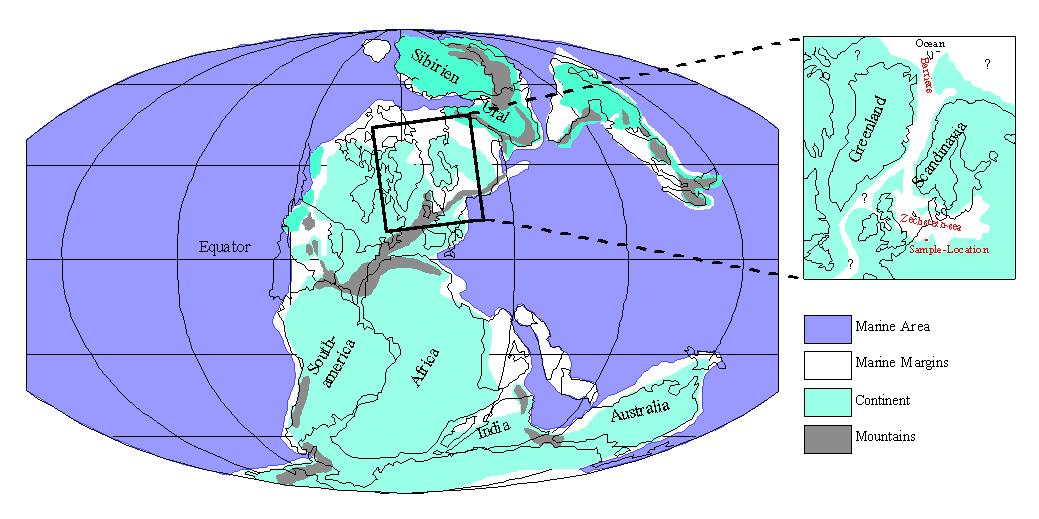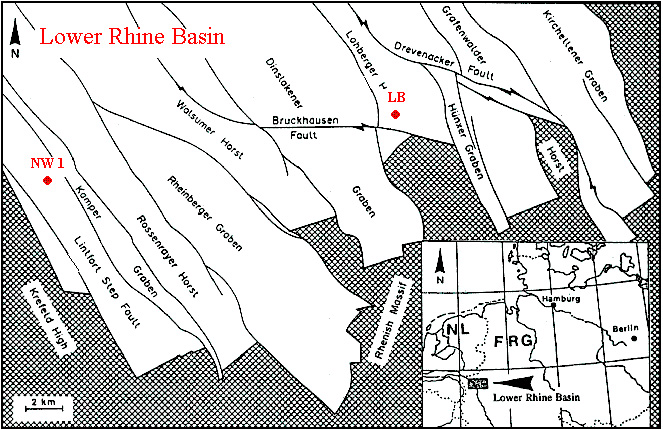

The Kupferschiefer is a typical bituminous marl which extends from england about netherland and germany to poland. This black shale contains high concentrations of organic material (TOC up to 20%), sulfides (mainly iron-sulfides like pyrite) and partly anomal high concentrations of zinc, copper, lead and barium. The sediments have been deposited 260 million years before, when the big landmasses Laurasia and Gondwana conected in Permian centre. Before the Old-Red-Continent was rather dry, and in middle europe existed a wide dry basin. Because of increase of sea-level and subside of landmasses between greenland and fenno-scandia, seawater incursed into the large basin from north. The basin could be filled with seawater in the short time of only 10 years. The environmental conditions changed from territorial to marine. The Zechstein sea covered middle europe. The early marine system was relatively rich at nutrients. This leaded propably to a strong production of biomass and a high accumulation rate of organic material in the sediments. It seems to be undeniable that the strong stream of organic debris to the seaflow leads to a consumption of oxygen within the watercolumn. The Kupferschiefer has been deposited under anoxic (euxinic) conditions in the water column.
The ore mineralisation probably is a diagenetic process which takes place millions of years later. The source for the metals is probably the underlying Rotliegend (early Perm) or Carboniferous material. Different work can show this (for example: Sun, Y., Puettmann, W. (1997) Metal accumulation during and after deposition of the Kupferschiefer from the Sangerhausen Basin, Germany.Applied Geochemistry 12, 577-592 and Vaughan D. J., Sweeney M., Friedrich G., Diedel R., and Haranczyk C. (1989) The Kupferschiefer: An overview with an appraisal of the different types of mineralisation. Economic Geology 84, 1003-1027). In the Lower Rhine Basin copper is slightly enriched compared to average shale, because the Rotliegend is missing and the Kupferschiefer is deposited directly above the carboniferous material.
The aim of our work is to investigate the inorganic chemistry in high resolution to detect cycles in environmental conditions. Further we compare the minor-element concentrations with recent anoxic sediments like the Black Sea or other Black shales to get more detailed informations about the redoxconditions in the watercolumn and at the sediment-water interface. Some elements like V, Mo, Re, U, Co, Ni can be used to empathize the conditons during sedimentation.
The world permian: Sample Location:
This work is founded by the "Deutsche Forschungsgemeinschaft". It is a part of a special investigation program with the title "Evolution des Systems Erde während des jüngeren Paläozoikums im Spiegel der Sedimentgeochemie". Leading Coordinator of this project is Prof Dr. W. Buggisch (Institute for Geology, University Erlangen, germany).
|
|
20.07.99
|